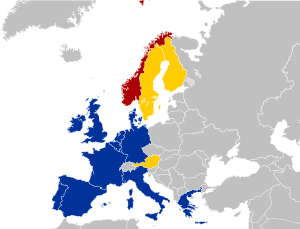Treaty of Accession 1994
| |
|---|---|
|
Countries involved in the treaty, with newly joining countries in yellow, countries who did not join in red, and existing EU countries in blue. | |
| Signed | 26 July 1994 |
| Location | Brussels |
| Effective | 1 January 1995 |
| Condition | ratification by Norway, Austria, Finland or Sweden and all 12 Member States of the European Union |
| Signatories | 16 |
| Ratifiers |
15 / 16 |
| Depositary | Government of the Italian Republic |
| Languages | All 9 official Languages of the European Union, Norwegian, Finnish and Swedish |
The Treaty of Accession 1994 was the agreement between the member states of the European Union and four countries (Norway, Austria, Finland and Sweden), concerning these countries' accession into the EU. It entered into force on 1 January 1995. The Treaty arranged accession of Austria, Finland and Sweden to the EU and amended earlier Treaties of the European Union. As such it is an integral part of the constitutional basis of the European Union. Norway failed to join the EU because its referendum did not pass.[1][2]
Full title
The full official name of the treaty is:
Treaty between the Kingdom of Belgium, the Kingdom of Denmark, the Federal Republic of Germany, the Hellenic Republic, the Kingdom of Spain, the French Republic, Ireland, the Italian Republic, the Grand Duchy of Luxembourg, the Kingdom of the Netherlands, the Portuguese Republic, the United Kingdom of Great Britain and Northern Ireland (Member States of the European Union) and the Kingdom of Norway, the Republic of Austria, the Republic of Finland, the Kingdom of Sweden, concerning the accession of the Kingdom of Norway, the Republic of Austria, the Republic of Finland and the Kingdom of Sweden to the European Union.
Referendums
See also
References
This article is issued from Wikipedia - version of the 1/8/2016. The text is available under the Creative Commons Attribution/Share Alike but additional terms may apply for the media files.

